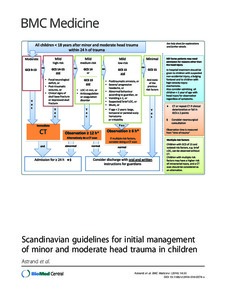Scandinavian guidelines for initial management of minor and moderate head trauma in children
Astrand R, Rosenlund C, Undén J; and for the Scandinavian Neurotrauma Committee (SNC)
https://urn.fi/URN:NBN:fi-fe2021042715752
Tiivistelmä
Abstract
BACKGROUND:
The management of minor and moderate head trauma in children differs widely between countries. Presently, there are no existing guidelines for management of these children in Scandinavia. The purpose of this study was to produce new evidence-based guidelines for the initial management of head trauma in the paediatric population in Scandinavia. The primary aim was to detect all children in need of neurosurgical intervention. Detection of any traumatic intracranial injury on CT scan was an important secondary aim.
METHODS:
General methodology according to the Appraisal of Guidelines for Research and Evaluation (AGREE) II and the Grading of Recommendations Assessment, Development and Evaluation (GRADE) system was used. Systematic evidence-based review was performed according to the Preferred Reporting Items for Systematic Reviews and Meta-Analyses (PRISMA) methodology and based upon relevant clinical questions with respect to patient-important outcomes. Quality ratings of the included studies were performed using Quality Assessment of Diagnostic Accuracy Studies (QUADAS)-2 and Centre of Evidence Based Medicine (CEBM)-2 tools. Based upon the results, GRADE recommendations, a guideline, discharge instructions and in-hospital observation instructions were drafted. For elements with low evidence, a modified Delphi process was used for consensus, which included relevant clinical stakeholders.
RESULTS:
The guidelines include criteria for selecting children for CT scans, in-hospital observation or early discharge, and suggestions for monitoring routines and discharge advice for children and guardians. The guidelines separate mild head trauma patients into high-, medium- and low-risk categories, favouring observation for mild, low-risk patients as an attempt to reduce CT scans in children.
CONCLUSIONS:
We present new evidence and consensus based Scandinavian Neurotrauma Committee guidelines for initial management of minor and moderate head trauma in children. These guidelines should be validated before extensive clinical use and updated within four years due to rapid development of new diagnostic tools within paediatric neurotrauma.
Kokoelmat
- Rinnakkaistallenteet [19207]
